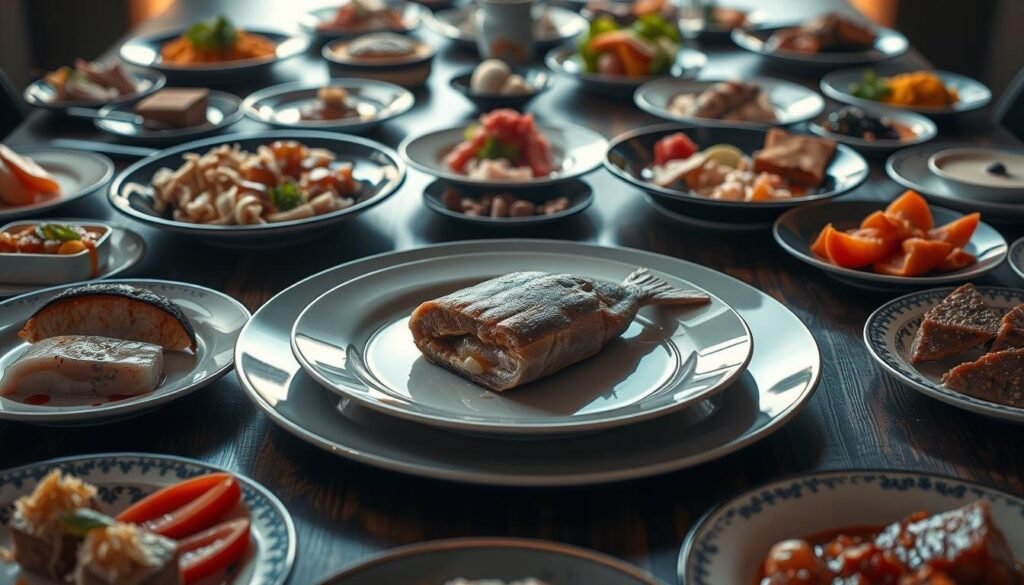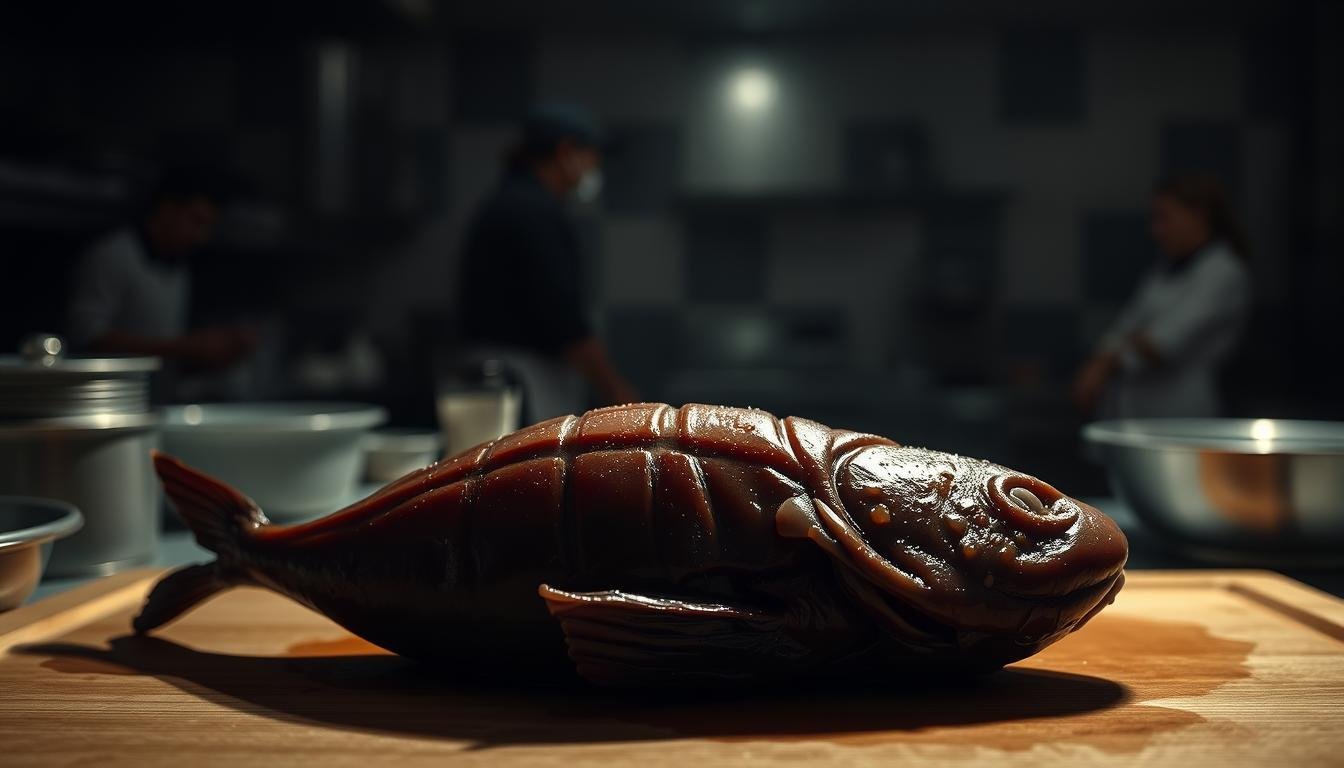Have you heard that monkfish liver is banned in Europe? Wondering why? This delicacy has sparked a big debate.
We’ll look into why it’s banned. You’ll see how Europe’s food regulations play a big role. This article will explain the monkfish liver ban and its effects.
By diving into the rules and the culture around monkfish liver, we hope to clear up the mystery.
Contents
- 1 The Culinary Delicacy: Understanding Monkfish Liver
- 2 Why is Monkfish Liver Banned in Europe?
- 3 Health and Safety Concerns Behind the Ban
- 4 Regulatory Differences Around the World
- 5 The Controversy and Debate
- 6 Conclusion
- 7 FAQ
- 7.1 What is monkfish liver, and why is it considered a delicacy?
- 7.2 Why is monkfish liver banned in Europe?
- 7.3 What is Diarrhetic Shellfish Poisoning (DSP), and what are its symptoms?
- 7.4 Are there any other potential contaminants in monkfish liver?
- 7.5 How do food regulations differ around the world regarding monkfish liver?
- 7.6 What is the current debate surrounding the ban on monkfish liver?
- 7.7 Can I still consume monkfish liver in certain circumstances?
The Culinary Delicacy: Understanding Monkfish Liver
In Japan and some Asian countries, monkfish liver is a treasured dish. It’s loved for its rich, buttery taste and creamy feel. This makes it a key ingredient in fancy cooking.
Monkfish liver, or ankimo in Japanese, is often eaten raw as sashimi or sushi. To prepare it, the membranes and veins are removed, then it’s frozen to improve its texture. It’s served with sweet sake sauce, spicy momiji-oroshi, and grated daikon radish.
Monkfish liver is also good for you. It’s packed with protein, vitamins, and minerals like vitamin A and omega-3 fatty acids. These nutrients help your heart and fight inflammation.
Nutritional Highlights
- High in protein
- Rich in vitamin A
- Good source of omega-3 fatty acids
- Contains various essential minerals
Monkfish liver is also prized for its unique taste and preparation. Making and eating it is seen as an art. It shows the deep cultural value it holds in some places.
If you’re looking to try something new, monkfish liver is a great choice. Its special flavor and texture make for a luxurious and unforgettable dining experience.
Why is Monkfish Liver Banned in Europe?
The ban on monkfish liver in Europe comes from strict food safety rules and scientific studies. You’re about to learn how these rules affect this tasty dish.
Europe’s food laws aim to keep consumers safe. They use caution with new or risky foods. Monkfish liver is one such food, so it’s been carefully checked.
The European Food Safety Authority (EFSA) is key in checking food safety. They look at toxins and health risks in foods like monkfish liver.
Some big worries about monkfish liver are:
- High levels of toxins
- Risks of food poisoning from bad handling
- Need for strict controls on where and how it’s made
Europe’s food laws tackle these issues. They have:
- Checks before foods hit the market
- Regular checks on food products
- Clear labels and tracking food
Knowing about these rules helps you see why monkfish liver is banned in Europe.
Health and Safety Concerns Behind the Ban
The European ban on monkfish liver is due to health and safety worries. You might wonder why monkfish liver is seen as a health risk. The main worry is Diarrhetic Shellfish Poisoning (DSP), caused by toxins in contaminated shellfish.
Diarrhetic Shellfish Poisoning (DSP)
DSP is a serious health problem from eating bad seafood. Toxins in the liver can lead to severe stomach issues like diarrhea and vomiting. These symptoms can be very uncomfortable and last for days.
Toxins causing DSP come from algae that shellfish like monkfish eat. Eating contaminated monkfish liver can make you sick with these symptoms.
Monkfish liver might also have other harmful stuff. This includes heavy metals, pesticides, and pollutants that build up in the liver.
| Contaminant | Health Risk | Source |
|---|---|---|
| Heavy Metals | Neurological damage, organ failure | Pollution, industrial waste |
| Pesticides | Cancer, reproductive issues | Agricultural runoff |
| Pollutants | Various health problems | Industrial and domestic waste |
Knowing about these risks helps us understand why monkfish liver is banned in Europe. Regulatory bodies considered these dangers when they made the ban.
Regulatory Differences Around the World
Enjoying monkfish liver varies greatly by location. The rules around this delicacy are complex. They show different cultural views and food safety standards.
In Europe, monkfish liver is banned for strict food safety reasons. But in places like Japan and some parts of the United States, it’s a prized dish. It’s eaten with care.

| Region | Regulatory Status | Culinary Culture |
|---|---|---|
| Europe | Banned | Strict food safety regulations |
| United States | Regulated but available | Considered a delicacy in some regions |
| Japan | Regulated, consumed with precautions | Cultural acceptance of raw and exotic foods |
The table shows how different places handle monkfish liver. Europe has a strict ban. But other areas have more flexible rules. These reflect local food cultures and safety views.
Knowing these regulatory differences helps us understand the food controversy around monkfish liver. Exploring various cuisines teaches us about culinary restrictions. It shows how these rules influence our food choices.
The Controversy and Debate
Why is the monkfish liver ban so debated? It’s about finding a balance between food traditions and health safety.
Some say the ban is needed to keep people safe. They worry about health risks like food poisoning from eating monkfish liver.
Others think the ban limits their freedom in the kitchen. They see monkfish liver as a special dish and believe it can be safely prepared.
The debate isn’t just about health. It also affects the fishing and food industries. Looking at how different places handle monkfish liver can show us the ban’s effects.
| Region | Regulatory Approach | Economic Impact |
|---|---|---|
| Europe | Ban on monkfish liver | Loss of revenue for fishing and culinary industries |
| Japan | Permitted with regulations | Continued demand and economic benefit |
| United States | Permitted with guidelines | Balanced economic and health concerns |
The monkfish liver ban is a complex issue. Some believe it’s needed for health reasons, while others see it as a limit on food traditions.
The ongoing debate and controversy show we need more research and talk. By looking at different views and rules, we can understand the issue better.
Conclusion
You now know about the monkfish liver ban in Europe. This ban is a big deal because of worries about food safety and health risks. The cultural value of monkfish liver also plays a big role in this debate.
The rules around monkfish liver show the tricky balance between keeping traditions alive and protecting health. You’ve learned how this issue touches on many aspects, from health concerns to global regulations.
The monkfish liver ban is more than just a rule. It shows how food, culture, and safety are all connected. Now, you can see the different views on this dish and its place in various cultures.
FAQ
What is monkfish liver, and why is it considered a delicacy?
Monkfish liver is a seafood delicacy known for its rich, buttery taste and creamy texture. It’s loved in Japan and other Asian countries. There, it’s often eaten raw or in traditional dishes.
Why is monkfish liver banned in Europe?
Europe banned monkfish liver because of health risks. The main concern is Diarrhetic Shellfish Poisoning (DSP). This toxin can come from algae and harm people.
What is Diarrhetic Shellfish Poisoning (DSP), and what are its symptoms?
DSP is a sickness from eating shellfish with toxins. Symptoms include diarrhea, stomach pain, and vomiting. In severe cases, it can be very bad.
Are there any other potential contaminants in monkfish liver?
Yes, monkfish liver might also have heavy metals and pollutants. These can build up in the liver. Eating it could be risky for your health.
How do food regulations differ around the world regarding monkfish liver?
Rules about monkfish liver vary worldwide. Europe bans it, but Japan and the U.S. have different rules. Some places allow it under certain conditions.
What is the current debate surrounding the ban on monkfish liver?
The ban on monkfish liver is a big debate. Some say it’s needed for health reasons. Others think it limits food choices too much.
Can I still consume monkfish liver in certain circumstances?
You can still find monkfish liver in some places, like online or specialty stores. But, be careful. Make sure it’s from a trusted source.

Marcellus Stark is an investigative journalist from San Francisco, USA. He writes about global bans, rules, and unusual laws. He shares clear, interesting, and well-researched stories that help readers understand surprising facts worldwide.

